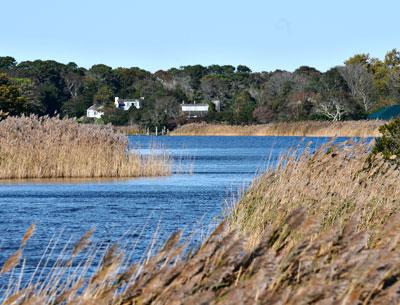To Fight Georgica Pollution

East Hampton Village plans to install or retrofit drains to stem the introduction of contaminated stormwater runoff into Georgica Pond following a declaration by the State Department of Environmental Conservation that the pond is a “pathogen impaired water body.”
Stormwater from 27 acres of public and private property as well as roads drain into the pond, but, according to Drew Bennett of the firm Engineering Consultants, only about 10 percent of the runoff comes from property in the village’s jurisdiction. The plan does not cover remediation of drains that are the responsibility of New York State, Suffolk County, or East Hampton Town.
The D.E.C. is calling for a 93-percent reduction in pathogens, a level called “unfeasible” in a village remediation report from Michael Bouker, the deputy superintendent of public works. The report blames coliform bacteria from waterfowl and wildlife for the pathogens, stormwater runoff from roads, as well as some contribution from old septic systems on waterfront properties. “These are beyond the control of the Village of East Hampton,” Mr. Bouker’s report states.
As the agency that administers the Environmental Protection Agency’s pollutant discharge elimination System stormwater program, the D.E.C. has tested Georgica Pond and used topographical maps to identify non-point sources of pollution within what are known as the Cove Hollow and Georgica Close watersheds.
The Cove Hollow watershed is the larger of the two, with contaminated stormwater entering the Georgica Cove section of the pond primarily through a concrete drain pipe that is part of a system constructed by the state. It carries stormwater from fields north of the village and adjacent to Route 114.
A section of the pipe runs through the village, roughly paralleling Cove Hollow Road, however, which has seven outlets, or vents, that allow stormwater from heavy rains to spill into low-lying areas north of Georgica Cove. Stormwater also enters the pond from two catch basins at the north end of Cove Hollow and Georgica Roads. The contribution from the smaller Georgica Close watershed comes primarily from private property and paved roads, the report states.
The village intends to install inserts to the vents along Cove Hollow Road to reduce pathogens, and put in four leaching pools along Georgica Road to catch rainwater.
In addition, “vegetative swales and riparian buffers will be constructed along portions of Georgica Road’s south side to capture and treat stormwater,” the report states, along with a pipe at the road-end near Georgica Cove. The area is also to be policed for litter and refuse.
In the Georgica Close watershed, buffers and vegetation will be installed along both Georgica and Georgica Close Roads. Without mentioning the costs involved, the report states that “these measures will be taken “without placing an undue burden on the taxpaying community.”
“We’re saying we will retrofit within the village jurisdiction, but our observations are that a much larger area of contribution” should be the responsibility of the State D.O.T. [Department of Transportation], and town,” Larry Cantwell, the village administrator, said on Tuesday.
East Hampton Town has also developed and submitted to the D.E.C. a remediation plan for the larger Georgica Pond watershed. The deadline for both plans was Sept. 30.
Mark Abramson, a senior environmental analyst for the town, said yesterday that contamination carried by stormwater is non-point-source pollution. Although antiquated septic systems might play a role in overall levels of contamination in Georgica Pond, he said, they were not identified in the remediation study.
“This is not new. Recognition of it is new,” said Diane McNally, clerk of the East Hampton Town Trustees. The nine-member panel owns and manages Georgica Pond on behalf of the public. Ms. McNally said the trustees had been aware of the problem for years, but had been told routinely that the systems contributing to the pollution were beyond their jurisdiction. “But, it impacts our waterway,” she said.
Ms. McNally said the trustees were well aware of runoff into Georgica Cove. The trustees had voiced their concern, she said, even though shellfish, which accumulate pathogens, are not usually taken from Georgica Pond. Crabbing is popular there, but crabs are not considered shellfish.
“We’ve been in touch with the shellfish bureau of the D.E.C. It’s upland runoff. Now they’re more aware of it,” she said.
“There’s a swamping spot on the north side of Route 27 where Stephen Hand’s Path enters, and a huge pond on Daniel’s Hole Road when it rains,” she said, referring to the trustees’ concerns. She went on to note that the trustees had worked with the town’s now-retired director of natural resources, Larry Penny, on the possibility of a “water garden,” or system of cascades, to slow the water flow between Hook Pond and North Main Street.
